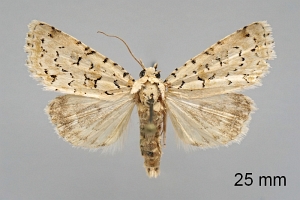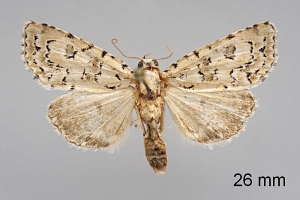

 +1Kontinente:EU
+1Kontinente:EU2. Diagnose
2.1. Männchen
2.2. Weibchen
3. Weitere Informationen
3.1. Andere Kombinationen
- Nyctobrya segunai Fibiger, Steiner & Ronkay, 2009 [Originalkombination und bis Vargas-Rodríguez et al. (2020) übliche Kombination]
3.2. Taxonomie
Die neu beschriebene Art wurde zunächst in die Untergattung Bryopsis der Gattung Nyctobrya gestellt, die dann von Vargas-Rodríguez et al. (2020) aber als eigene Gattung mit den weiteren Arten Bryopsis muralis und B. amasina herausgenommen wurde.
Vella et al. (2022: 8-9) legten erstmals Barcoding-Ergebnisse zu dieser Art vor, die allerdings einige Fragen aufwerfen: "Four specimens of N. segunai were identified during this study, with each having a unique haplotype and 99.0% identical nucleotide positions, with a mean pairwise identity of 99.5%. These data represent the first barcodes for N. segunai, which diverges from its closest related species, Nyctobrya muralis, by at least 1.8% using BOLD data and 3.3% using GenBank data. Phylogenetic analysis shows that, genetically, N. segunai forms a monophyletic clade within the paraphyletic N. muralis. The BI tree using both publicly available data (Figure 3) and BOLD TaxonID Tree (data not shown) indicates the presence of multiple clades for N. muralis, highlighting the need for taxonomic revisions of possibly undescribed cryptic species within the N. muralis complex. Four specimens of N. segunai were identified during this study, with each having a unique haplotype and 99.0% identical nucleotide positions, with a mean pairwise identity of 99.5%. These data represent the first barcodes for N. segunai, which diverges from its closest related species, Nyctobrya muralis, by at least 1.8% using BOLD data and 3.3% using GenBank data. Phylogenetic analysis shows that, genetically, N. segunai forms a monophyletic clade within the paraphyletic N. muralis. The BI tree using both publicly available data (Figure 3) and BOLD TaxonID Tree (data not shown) indicates the presence of multiple clades for N. muralis, highlighting the need for taxonomic revisions of possibly undescribed cryptic species within the N. muralis complex." In der Konsequenz bedeutet das, dass weitere Arten innerhalb des Komplexes beschrieben werden müssen - oder dass B. segunai zur Unterart zu degradieren wäre.
3.3. Faunistik
Wahrscheinlich Endemit von Malta.
(Autor: Erwin Rennwald)
3.4. Literatur
- Erstbeschreibung: Fibiger, M., Ronkay, L., Steiner, A. & A. Zilli (2009): Noctuidae europaeae 11. 1-504, pl. 1-13 [hier: 300-301, 340, 399, 451, pl. 12 figs. 37-41 (nicht 22-26, wie auf S. 300 angegeben)]. Sorø (Entomological Press).
- Vargas-Rodríguez, S. M., Fibiger, M., Honey, M. R., Ronkay, G., Yela, J. L., Zilli, A. & L. Ronkay (2020): Bryophila perloides Guenée, 1852 (Lepidoptera: Noctuidae: Bryophilinae), an overlooked member of the European Noctuidae fauna, with upgrading of Bryopsis Boursin, 1970 to generic level (Taxonomic studies on the western Palaearctic Bryophilinae, No. 1). — Zootaxa 4845 (1): 53-70. [zum Abstract auf mapress.com]
- Vella, A., Mifsud, C. F., Magro, D. & N. Vella (2022): DNA Barcoding of Lepidoptera Species from the Maltese Islands: New and Additional Records, with an Insight into Endemic Diversity. — Diversity 14 (1090): 1-18. [Zum PDF auf researchgate.net]





